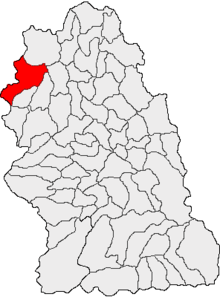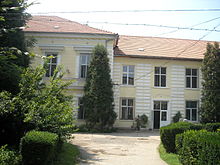Zam (Hunedoara)
|
Zam Sameschdorf Zám |
||||
|
||||
| Basic data | ||||
|---|---|---|---|---|
| State : |
|
|||
| Historical region : | Transylvania | |||
| Circle : | Hunedoara | |||
| Coordinates : | 46 ° 0 ′ N , 22 ° 27 ′ E | |||
| Time zone : | EET ( UTC +2) | |||
| Height : | 160 m | |||
| Area : | 161.88 km² | |||
| Residents : | 1,875 (October 20, 2011) | |||
| Population density : | 12 inhabitants per km² | |||
| Postal code : | 337550 | |||
| Telephone code : | (+40) 02 54 | |||
| License plate : | HD | |||
| Structure and administration (as of 2016) | ||||
| Community type : | local community | |||
| Structure : | Zam, Almaş-Sălişte , Almăşel , Brăşeu , Cerbia , Deleni , Godineşti , Micăneşti , Pogăneşti , Pojoga , Sălciva , Tămăşeşti , Valea | |||
| Mayor : | Sorin-Ionel Nistor ( PNL ) | |||
| Postal address : | Str. Principală, no. 149 loc. Zam, jud. Hunedoara, RO-337550 |
|||
| Website : | ||||
Zam ( German Sameschdorf , Hungarian Zám ) is a municipality in the Hunedoara district in Transylvania , Romania .
In Hungarian, the subdivision of the place into Kiszám (about "Klein-Sameschdorf") and Nagyzám (about "Groß-Sameschdorf") is known.
Geographical location
The municipality of Zam is located in the southwest of Transylvania, west of the Transylvanian Ore Mountains , south of the Zarand Mountains in the historical region of Hunyad County ( Eisenmarkt County ) in the Marosillye district . The place - a scattered settlement - is on the river Mureș ( Mieresch ), the European route 68 and the railway line Arad – Alba Iulia . The district capital Deva is located about 48 kilometers southeast of Zam.
history
The place Zam was first mentioned in a document in 1407. The Roman sculptures of Grafenburg Nopcsa which the Roman period indicate were - according to reports by JM Ackner , I. Torma (1856) (1882), C. Gooss, I. Martian, G. Téglás and other - of Sarmizegetusa and vétel by Zam brought. It is rather unlikely that there was a Roman settlement in Zam itself. In 1951 most of the objects were brought to Deva.
The main occupations of the population are forestry, cattle breeding, agriculture and work in gravel mining on the Mureș River and in the basalt and limestone quarries .
Once the place was also the center of rafting on the Mureș.
population
The population of the municipality developed as follows:
| census | Ethnic composition | |||||||
|---|---|---|---|---|---|---|---|---|
| year | population | Romanians | Hungary | German | other | |||
| 1850 | 3.816 | 3,719 | 8th | 6th | 83 | |||
| 1910 | 6,603 | 6,341 | 201 | 51 | 10 | |||
| 1977 | 3.137 | 3,096 | 10 | 9 | 22nd | |||
| 2002 | 2.148 | 2,027 | 11 | 3 | 62 | |||
The highest population of today's municipality - and at the same time that of Hungarians - was in 1910; that of the Romanians (6,392) in 1900, that of the Germans (60) in 1890 and that of the Roma in 1850.
In addition, in 1966 and 1977 one resident each designated themselves as Ukrainians , 23 in 1992 and 52 in 2002 , one each in 1880, 1966 and 1977, and two each in 1900 and 1956 as Serbs . Almost every recording since 1900 - except 1910, 1920, 1941 and 1977 - also recorded Slovaks ; the highest number of Slovaks (17) was recorded in 1966.
Attractions
- The wooden church Naşterea Sf. Ioan Botezătorul , built in the 18th century, is a listed building.
- The castle of Nopcsa Laszlo with park, built in the 19th century, is a listed building. The castle was once the property of the notorious Nocsa family, from which the robber chief Fața Neagră (“Black Face”) is said to come from, from which the novel “Poor Peasants” by Mór Jókai is about.
- The wooden church Înălțarea Domnului , built in 1761 in the incorporated village of Micăneşti , is a listed building.
- The wooden church Sf. Arhangheli , in the incorporated village of Almaş-Sălişte , the wooden church Sf. Apostoli in the incorporated village of Pogăneşti and the wooden church Cuvioasa Paraschiva in the incorporated village of Sălciva , all built in the 18th century, are listed.
- The wooden church Buna Vestire , built in the 18th century in the incorporated village of Cerbia , is not a listed building.
Personalities
- László Paál (1846–1879), Hungarian painter
Web links
Individual evidence
- ↑ 2011 census in Romania at citypopulation.de
- ^ Dictionary of the localities in Transylvania
- ↑ a b c Heinz Heltmann, Gustav Servatius (ed.): Travel Guide Siebenbürgen. Kraft, Würzburg 1993, ISBN 3-8083-2019-2 .
- ^ Institute Of Archeology - Zam, accessed November 6, 2010 (Romanian)
- ↑ Census, last updated November 2, 2008, p. 173 (Hungarian; PDF; 1.1 MB)
- ↑ a b c d List of historical monuments of the Romanian Ministry of Culture, updated 2010 (PDF; 7.10 MB)
- ↑ Information on the church in Cerbia from biserici.org accessed on April 21, 2013 (Romanian)









